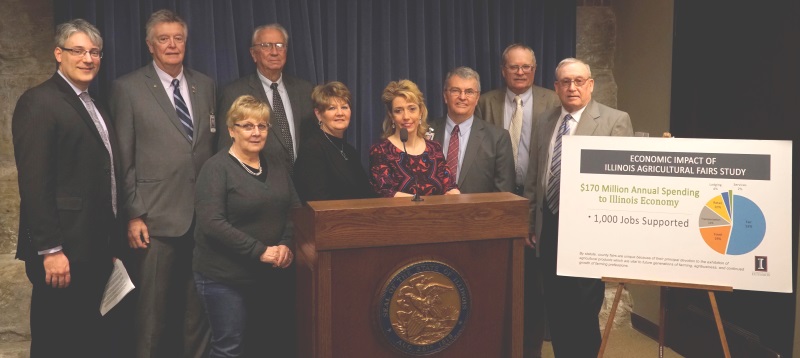In Springfield, IL, Legislators and County Fair officials gathered at the Statehouse, on Thursday, March 8, 2018, to showcase the positive economic benefit County Fairs bring to the State and to urge Governor Bruce Rauner to release $1.4 million in Rehab Fair Funding, that was appropriated as part of FY18, which passed last year. Pictured left-to-right are Representative Mike Halpin (D-Rock Island); Representative Steve Reick (R-Woodstock); Sandy Moore (Jersey County Fair); Marv Perzee (Iroquois County Fair); Rita Williams (Mercer County Fair); IL Association of Ag Fairs Governor Affairs Director Margaret Vaughn; Representative Tom Bennett (R-Gibson City); Tom Moore (Jersey County Fair); Ken Tyrell (Sandwich Fair.)

The Illinois Association of Agricultural Fairs highlighted the results of a University of Illinois Extension Department of Community and Economic Development study. Research revealed that County Fairs bring $170 million annually to the State’s economy and support 1000 non-fair related jobs.
“Local County Fairs provide both measurable economic benefits and immeasurable community benefits, to Central and Southern Illinois communities. I urge the Governor and his administration to do the right thing and release this funding, which will help downstate communities that have struggled in the recent past,” said State Senator Dave Koehler.
“County Fairs are distinguished from other events in State statute because of their agricultural component. Researchers divided the State into three geographic regions, and, within each zone, all County Fairs were sorted according to their estimated attendance. A cross section of fairs was also studied, taking geographic location into account. The selection process produced a sample and data set that would best represent all fairs across the State. The economic study results show $170 million is spent in the State annually as a result of our County Fairs, with $90 million being spent within the actual fairgrounds and the other $80 million in ancillary sales in local communities,” explained IAAF Government Affairs Director Margaret Vaughn.
She explained further that the money spent within the fairgrounds, including gate fees, event tickets, food, carnival passes, and entertainment is only one-of-seven categories studied to determine the economic impact of the fair. The other six ancillary categories focused on money spent in the local economies outside of the fairgrounds and included outside purchases of food (restaurants, diners, etc.), transportation (fuel, rental cars, convenience stores), retail (grocery, merchandise, hardware), lodging (hotels, campgrounds) and commercial services (laundry, mechanics, healthcare.)
“What is important about these numbers is that it shows that County Fairs are economic engines in our State, especially in rural areas, many of which are economically disadvantaged and have limited employment opportunities,” said Marvin Perzee of the Iroquois County Fair.
“County Fairs are an economic stimulus across the State, especially in rural areas. I encourage the Governor to recognize the important role they play in our communities and release the funding immediately,” urged State Senator Heather Steans.
“County Fairs provide a venue for competitions, which raise the bar for the development of agricultural products within the State. Youth programs of 4-H and FFA are imperative to insuring future generations’ continued dedication to farming,” explained State Representative Steve Reick.
“From a socioeconomic as well as agribusiness perspective, I think it is important to point out that County Fairs are the backbone of our agricultural communities in the State of Illinois. The money the State has appropriated to them is an investment in our agricultural economy and needs to be released,” said Senator Jil Tracy.
The full study can be found on the IL Association of Agricultural Fairs website: https://docs.wixstatic.com/ugd/cfc958_995532498dcd475398b606ca3f9eee83.pdf.
